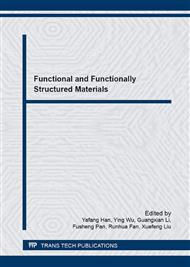p.696
p.703
p.709
p.717
p.722
p.726
p.733
p.738
p.743
Preparation and Characterization of Water Absorbing and Anti-Fogging Coatings
Abstract:
Anti-fogging functional coatings have a broad application prospective in the fields of construction and transportation vehicles. In this study, superior water absorbing and anti-fogging coatings were prepared by a cure reaction using epoxy resins as water absorbent resins, hydroxyethyl ethylenediamine as a curing agent, γ-ammonia propyl triethoxy silane as a coupling agent, organic silicon sol as filler. The impact of additional polyethylene glycol (PEG) on the properties of water absorbing and antifogging coating has also been studied. The anti-fogging experiments were conducted in a 40 °C water steam bath, and the result shows that the sample with additional 4.0 % PEG has an anti-fogging time of 315 seconds (s), which is better than that without PEG (the anti-fogging time being 240s). Infrared spectroscopy and scanning electron microscope structure characterization indicate that the sample with additional PEG has an obvious three-dimensional network structure with hydroxyl groups, which leads to a great saturated water quantity and a superior anti-fogging performance.
Info:
Periodical:
Pages:
722-725
Citation:
Online since:
March 2016
Authors:
Keywords:
Price:
Сopyright:
© 2016 Trans Tech Publications Ltd. All Rights Reserved
Share:
Citation:


